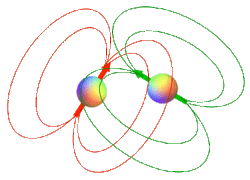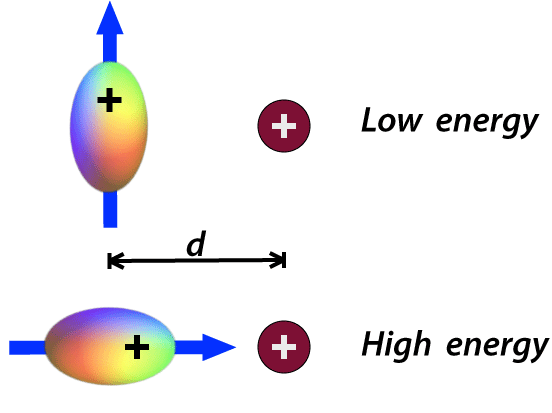|
Biological tissues, however, are infinitely more complex, with internal microstructures containing water and larger molecules distributed nonuniformly and within compartments. As such, no comprehensive quantitative theory has yet been developed that easily explains, for example, why liver or brain have the specific T1 and T2 values that they do. Nevertheless, much insight can still be gained by understanding the six basic mechanisms responsible for relaxation in simpler substances.
|
PRINCIPAL RELAXATION MECHANISMS |
|
As described in a previous Q&A the electromagnetic field from a particle can be considered to emanate from an idealized tiny bar magnet with north and south poles (the "dipole"). For our purposes the term dipole is synonymous with either a nucleus (proton) or an unpaired electron. A dipole-dipole interaction is a "through space" interaction of the fields from two such spinning particles. If the spins reside on the same molecule it is called an intramolecular dipolar interaction; if on different molecules an intermolecular interaction.
|
|
Electron clouds in molecules provide shielding of nuclei from the full intensity of an externally applied magnetic field (Bo). The resonance frequencies of ¹H nuclei will vary slightly depending on shielding in their local molecular environments. This is known as a chemical shift and forms the basis for MR Spectroscopy.
|
|
Any physical process that causes a molecule to move between different local environments during the course of an MR experiment can result in relaxation. The displacement may be due to translation of the molecule by a chemical, electrical, or gravitational gradient. It might be an organized, en masse displacement of many molecules, as in blood or CSF flow. Or it might be an entirely random process due to microscopic diffusion, the thermally-induced displacements of molecules due to Brownian motion.
|

|
Scalar (J)-Coupling
Scalar- or J-Coupling is an interaction of two nuclear spins on the same molecule transmitted through distortions in electron clouds. This contrasts with dipole-dipole interactions that occur via direct electromagnetic interactions "through space" and do not require an electron cloud intermediary. |
|
Electric-Quadrupole Coupling
Quadrupolar coupling is an extremely powerful and the dominant relaxation mechanism for nuclei (such as ²³Na) with spin quantum numbers (I) > ½. Such nuclei possess nonspherical charge distributions (quadrupolar moments). They interact powerfully with electric (rather than magnetic) field gradients in surrounding electron clouds, resulting in unequal splitting of the quadrupolar energy levels. I = ½ nuclei like ¹H have spherical charge distributions so do not relax by this mechanism. |
Advanced Discussion (show/hide)»
A few other interesting relaxation mechanisms are worth mentioning just for completeness. . . .
Spin-rotation interaction. This is the dominant relaxation mechanism in gases at high temperatures. In biological molecules, terminal methyl (-CH3) groups may spin and act as relaxation "sinks" whose magnetization has been passed down the molecule by spin diffusion. This effect is probably only of minor importance in large molecules (>10,000 Da) and at frequencies of 200 MHz or higher.
Hyperfine coupling/Knight shift Relaxation in metals takes place primarily by interactions between nuclei and delocalized conduction electrons. The mechanism is called "hyperfine coupling" and resembles J-coupling but is of much greater magnitude. Because each nucleus is coupled to many electrons the NMR energy spectrum collapses into a single peak whose position changes based on relative populations of electronic states. This "Knight shift" is the analog of the chemical shift seen in diamagnetic materials.
Bloembergen N, Purcell EM, Pound RV. Relaxation effects in nuclear magnetic resonance absorption. Phys Rev 1948;73(7):679-712. (The classic paper where the concepts of spin-lattice and spin-spin relaxation are developed formally as well as the recognition of inhomogeneity effects that we now call T2* but which the authors called T2').
Carr HY, Purcell EM. Effects of diffusion on free precession in nuclear magnetic resonance experiments. Phys Rev 1954;94(1):630-8. (Although Hahn described the effects of diffusion on spin-echoes four years previously, this paper takes the concept a step further).
Hahn EL. Spin echoes. Phys Rev 1950;80(4):580-594. (A "must-read". This paper has it all. Hahn was just a graduate student when he wrote this!)
Simpson JH, Carr HY. Diffusion and nuclear spin relaxation in water. Phys Rev 1958;111(5):1201-2. (Shows that in water at physiological temperatures T1 ∝ Diffusion constant (D) ∝ Temperature)
Torrey HC. Bloch equations with diffusion terms. Phys Rev 1956;104(1):563-5.





